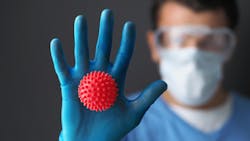Infection control in your dental office: Strategies to get everyone on board
In RDH magazine’s recent dental unit waterline survey, one frustration voiced multiple times was difficulty getting the team or the doctor on board with proper IC. Here's an example:
I joined a new office recently. I love the dentist and the team, but the infection control (IC) needs some work. I’ve been making suggestions, but they keep telling me it’s expensive and not required. How can I get my new office to be compliant?
If I had responded directly, I would have said something like: Let’s face it—it takes time and money, and if you’re in private practice, the likelihood of encountering an inspection is low. I’m glad that not only do you know better, but you want to provide a safe environment for both you and your patients.
IC in dentistry can be confusing. Between what’s a rule, what’s a guideline, what products to choose, and how to use them, dental teams often think they are doing the right thing when they aren’t. The adage “we’ve always done it this way” doesn’t work with IC. It leads to legacy errors where teams perform outdated or insufficient processes.
Find the motivator
Taking time to figure out what pushes someone to action will go a long way toward getting them on board. The Rowe and Boulgarides Decision Style Theory is a widely accepted model for how different people make decisions.1 It breaks decision-making into four styles.
You might also be interested in: Dental aerosols and the pandemic: A necessary wake-up call
Directive: These individuals are quick to come to a solution. They have a low tolerance for ambiguous ideas. They often look to their own knowledge and judgment to make a fast decision. Be sure to give them clear facts in bullet points. Chances are, the CDC or state guidelines are too wordy and full of ambiguity. Create a clear action plan for any issue you point out.
Analytical: These folks require time and information before making a decision. Have documentation ready, preferably from multiple reliable sources, and don’t expect a quick decision. The CDC’s Infection and Prevention Control in Dental Settings,2 the Organization for Safety, Asepsis, and Prevention (OSAP),3 and your state and local guidance are great places to look for accurate information.
Conceptual: These are big-picture people who are willing to take risks. They look for creative solutions that work long term. Be ready with compliant traditional and nontraditional solutions.
Behavioral: This decision-making style has more to do with relationships than the task itself. These people will listen to the information you bring without seeing it for themselves, but they'll require team consensus before moving on. Create a plan for how new tasks will impact others. Have another team member advocate with you and emphasize how these changes will help keep everyone safe.
If your decision-making style differs from the person you are talking to, it can be a frustrating process, but you can come prepared once you know how they operate.
Start with one thing
I remember an office I worked in many years ago. A new hygienist came in and in the first week had identified a dozen things we were doing wrong. Instead of being able to learn from her up-to-date information, we felt attacked.
I’m not saying all aspects of IC aren’t necessary, but some have more ramifications than others. Start with the worst stuff first. Make sure everyone understands why. That way, the changes won't feel like busywork. Once that’s fixed, move on to the next thing.
Annual OSHA training
Every state requires an annual OSHA and bloodborne pathogens training, and some require additional IC training. Find out the last time your office had one. This might be just the update that everyone needs—they might not realize they aren’t up to date. At least you’ll have someone backing up the changes you’ve been pushing.
Editor's note: This article appeared in the January/February 2024 print edition of RDH magazine. Dental hygienists in North America are eligible for a complimentary print subscription. Sign up here.
References
1. Rowe AJ, Boulgarides JD. Managerial Decision Making: A Guide to Successful Business Decisions. Macmillan Publishing Company; 1992.
2. Infection Prevention and Control in Dental Settings. Centers for Disease Control and Prevention. Reviewed October 24, 2023. https://www.cdc.gov/oralhealth/infectioncontrol/index.html
3. Quackenbush A. OSAP: Dental Infection Prevention & Safety Association. Organization for Safety, Asepsis, and Prevention. https://www.osap.org/
Amanda Hill, BSDH, RDH, CDIPC, describes her career in dental hygiene as an adventure. Growing up and marrying into the military, she experienced dentistry throughout the world. She is a speaker, consultant, and award-winning author. A member of the advisory board for RDH magazine and the recipient of OSAP’s Emerging Infection Leader award, Amanda strives to make topics in dentistry accurate, accessible, and fun.
About the Author

Amanda Hill, BSDH, RDH, CDIPC
Amanda Hill, BSDH, RDH, CDIPC, is an enthusiastic speaker, innovative consultant, and award-winning author who brings more than 25 years of clinical dental hygiene and education to dentistry. Recipient of ADS’s Emerging Infection Control Leader award and an active participant with the advisory board for RDH magazine, DentistryIQ, and ADS’s Infection Control in Practice Editorial Review Board and membership committee, Amanda (also known as the Waterline Warrior) strives to make topics in dentistry accurate, accessible, and fun. She can be reached at [email protected].
